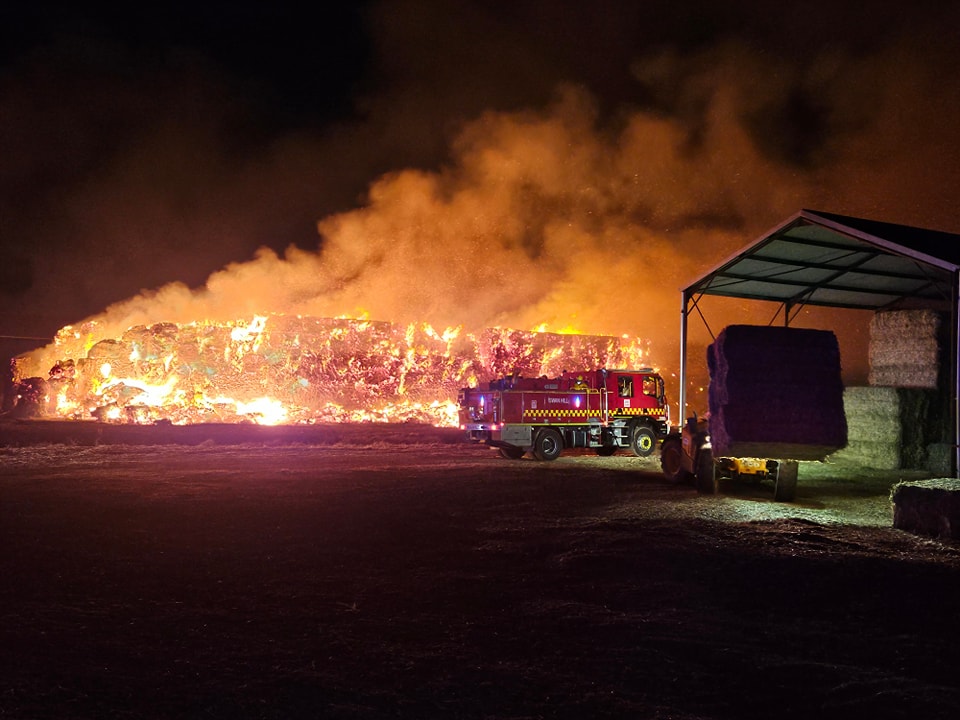 Image provided by Swan Hill Fire Brigade
Image provided by Swan Hill Fire Brigade
An earlier hay season has Victorian farmers and CFA talking about the dangers of high moisture content in hay as they begin cutting, baling and storing it in warmer conditions.
Just this week we saw the repercussions of hot northerly winds, when seven hay sheds, each with 800 bales of hay, caught on fire in Kerang following a damaging ember attack.
Kerang Captain Ramon Steel said crews arrived on scene to just one hay shed engulfed in fire, before an unexpected wind change initiated an uncontrollable firestorm.
"Several hours later we were hit with an ember attack and the fire spread to a further six sheds," Ramon said.
"We had 26 CFA units on scene and were able to utilise the appliances and volunteers available to save the other 13 sheds.
"Multiple grass fires broke out but were easily contained. However, nothing could be done to stop the shower of sparks that headed straight for the sheds in line of fire due to the direction and strength of the wind."
Hailing it as one of the worst fires he has witnessed in his 39 years as a firefighter, Ramon said crews will remain on scene patrolling the burning sheds as they continue to self-extinguish.
Unfortunately, a haystack fire is not unusual to CFA, having responded to almost 52 haystack related fires between 1 July 2022 and 30 June 2023.
CFA Chief Officer Jason Heffernan said if hay is baled with high moisture content and is green, it can heat up like compost, which can lead to spontaneous combustion weeks or months later.
"Farmers who have decided to carry on with hay production need to be extra vigilant this year to make sure conditions are right for making hay and for the future storage and transport as well," CO Heffernan said.
"Hay fires are a real threat to properties and stock in primary production areas.
"Whether you're a seasoned hay grower or switching to hay this year, it's imperative to take care of your hay and crops this fire season.
"Consider the storage of your hay to avoid spontaneous combustion which can lead to ignition. "
When hay is either not properly cured and dried out before baling, or not stored to protect it from rain or damp conditions, moisture content in the bales is then higher than the recommended level. If stored in environments with high temperatures and little airflow, a biological reaction could lead to a fire.
Haystack fires can also start easily from lightning strikes or sparks from equipment.
"You should regularly monitor your haystacks by using a temperature probe or a crowbar to detect heating hay," CO Heffernan said.
"Signs of heating hay can include steam rising from the stack or unusual odours like burning, must, pipe tobacco smell or a caramel smell.
"By being vigilant, you're protecting yourself from the financial impact of losing valuable fodder and protecting your property and family from the potential danger of hay fires."
Haystack Tips
- Ensure hay is well cured before baling.
- Know the history of the hay you purchase.
- Keep haystacks to a limited size and separate your haystacks.
- Monitor moisture and temperature of your hay regularly.
- Watch for unusual odours such as pipe tobacco, caramel, burning or musty smells.
- Store hay in separate stacks or sheds away from farm equipment and other buildings.
- Keep your hay dry. Protect it from rain, leaking rooves or spouts, and runoff. Cover stacks with tarps or hay caps.
- Don't stack hay right to the top of a hay shed. Allow some air to circulate at the top - this helps to carry away moisture.
Temperature Guide (degree celsius) - what to do when your hay is overheating
Use a thermometer in a probe or insert a crowbar into the middle of the stack for 2 hours.
- Less than 50 Can handle the crowbar without discomfort
Check temperature daily.
- 50 - 60 Can only handle crowbar for short time
Check temperature twice daily.
- 60 - 70 Can touch bar only briefly
Check temperature every 2 - 4 hours. Move hay to improve air flow.
- Over 70 Bar is too hot to hold
Potential for fire. Call 000 immediately. Avoid walking on top of haystack. At this stage pulling apart the hay may provide the oxygen it needs to ignite.






